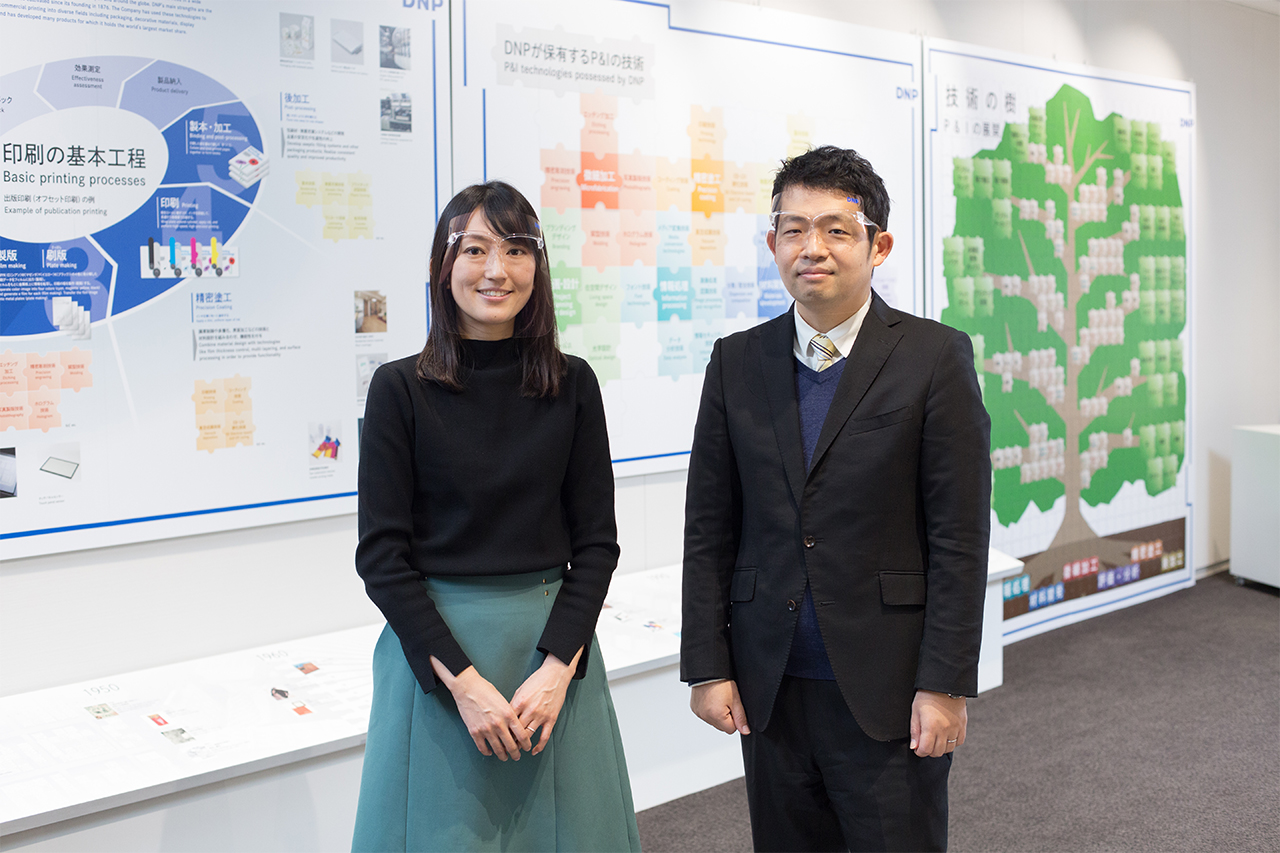
State-of-the-art device: From wearable to “wearless”
A skin display device is stretchable electronics that flexibly changes size in accordance with bodily motion when applied to the skin. Called “wearless” because of its comfortable and very little wearing feeling, this “wearless” device is getting a lot of attention due to having potentially wider applications than conventional displays. This advanced technology was successfully developed by a research team of the University of Tokyo and Dai Nippon Printing Co., Ltd. (DNP), led by Professor Takao Someya. We would like to explain how this amazing technology works and what its expected applications are.
- Success in developing an ultrathin, stretchable skin display
- DNP’s own technology makes stretchable electrodes possible
- Possibilities presented by “wearless” skin electronics
Success in developing an ultrathin, stretchable skin display
The skin display device developed by the University of Tokyo-DNP research team expands and contracts in accordance with the user’s motion when applied to the skin like an adhesive bandage. A recently unveiled prototype features a 1-millimeter-thick display made of a rubber sheet on which micro-LEDs (16 x 24 units) are inserted at equally spaced intervals. When adhered to the skin, it displays the electrocardiographic waveforms it measures.
Its biggest advantages are a high expansion/contraction rate of 45 percent (meaning it stretches or shrinks 45 percent of its original strength) and that no disturbance is visible on the display’s images during expansion and contraction. Many previously developed bendable or stretchable displays have shortcomings, such as partial darkness of LEDs caused by changes in voltage when stretched, or damage caused to electrode wiring when subjected to repeated expansion and contraction. This skin display device has overcome these problems.
*The skin electronics device developed by the University of Tokyo and DNP received the Minister for Internal Affairs and Communications Award/ACC Grand Prize of ACC Tokyo Creativity Awards.
Prize-winning skin electronics device ©Taiyo Kikaku Co., Ltd.
DNP’s own technology makes stretchable electrodes possible
The research team was able to overcome various technological limitations thanks to its ingenious approach to the structure of electrodes. Similar conventional displays can malfunction, because a great deal of force is applied to the joining section of hard and soft materials when they are stretched. In the display device developed by the research team, the electrode materials are folded and stored like an accordion, resulting in a structure that is much less likely to break. The team was also able to give it enough strength to withstand repeated use by putting a special layer on the surface. In developing this special layer, the team used laminating and patterning technologies that DNP developed in its printing business.
*Patterning technology: Capable of producing letters and images on a substrate.
Health care is one field where this skin display device has potential applications. Real-time displays of vital signs such as electrocardiographic waveforms and pulses will be useful in areas such as in-home and remote health care, as well as hospital care.
Possibilities possessed by “wearless” skin electronics
The technology used in developing this device opens up new horizons. The ability to stick to the skin has the potential to revolutionize personal information terminals. Previous information systems usually took up an entire room, but their size was reduced as technology advanced to desktop PCs, laptop PCs and eventually to tablets and smartphones that can be held in the palm of your hand. Watch-type and glass-type wearable devices have now come onto the market. This new skin display device marks the start of a new era in which “wearless” devices fuse the human body with electronic devices.
For example, runners can learn about the course they are running or their lap time by looking at the display, and collecting data such as muscle activity can help them adjust their running form and prevent injuries. People can display electronic tickets when they go to a concert or an event, while employees can display their entry pass when entering the workplace. And factory workers can use the device to look at industrial equipment manuals when they need to. Further improvement of display performance could lead to making skin displays fashion items that show high-definition colors and patterns on certain parts of the body, along with various types of information.
|
|
The skin display’s high degree of flexibility makes it suitable for use on irregular surfaces. It can be applied to Internet of Things (IoT) technology, such as collecting data through sensors applied to soft or stretchable materials, which until now has been difficult to do. Possible future applications include soft robotics, such as artificial hands and arms with a sense of touch acquired by collecting data from the texture and weight of a given item the user touches, for example. This data is then sent to the brain.
The team plans to address various technical issues, such as the further enhancement of reliability, higher density integration of its components and increasing area dimensions by optimizing its structure so that it can be used in a broad range of applications.
|
|
The skin display device has more potential than just being stuck to the skin and used as a terminal to display information. It has created the new field of skin electronics, a technology that paves the way for a new form of electronic devices. It might not be too long before such devices will be everyday items that we take for granted.
*The content of this article is correct as of the release date.
News release dated on July 13, 2020: Success in Making Skin Display Full Colors
DNP and the University of Tokyo have jointly developed an ultrathin, stretchable communication system that can be stuck onto the skin and which can display various pieces of information. On July 13, they announced that they had succeeded in making a display device that integrates a full-color display, drive component, communication circuit and power supply. The team plans to commercialize the display as a technology to accurately monitor biodata and provide smooth access to biodata.
A short movie that introduces applications for metaverse utilizing stretchable electronics
- *DNP department names, product specifications and other details are correct only at the time of writing. They are subject to change without prior notice.
- *Last updated date: June 30, 2022
May 8, 2019 by DNP Features Editorial Department




